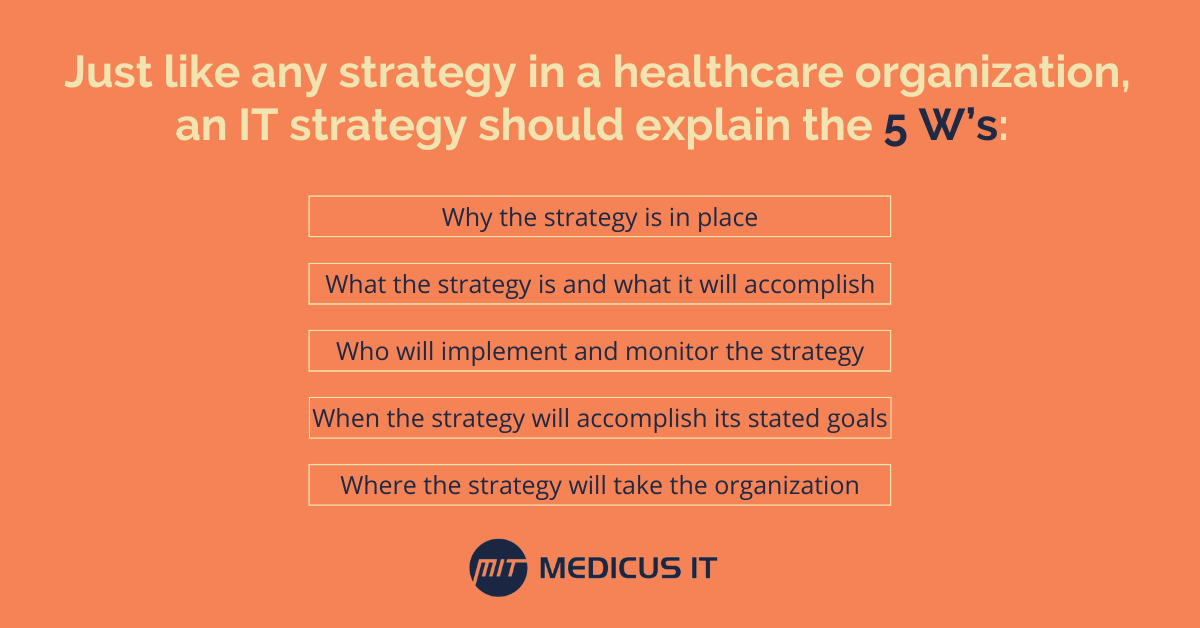Healthcare organizations focus on a mission and vision to set the tone for accomplishing goals, measuring metrics, envisioning the future, and inspiring employees. An information technology (IT) strategy should embrace your organization’s mission and vision while embodying the unique purpose of the IT department.
IT strategies are defined as a component of capability, but they involve more than just the foundational structure of computers, servers, and electronic health records. Your IT strategy should outline your organization’s ability to instill value by incorporating business assets and technological expertise.
As complicated as an IT strategy may appear, it is not a technical piece with intricate jargon. Your employees should be able to easily review and understand how your information technology strategy creates a positive impact on the organization and its patients.
When you consider the business needs of your organization, your IT strategy will set the tone for the future of healthcare. Learn about what an IT strategy can do for your organization, why it's needed, how to create a strategy, how to measure its success, and how it affects the future of healthcare in your community.

What is an IT Strategy, and Why Does Your Healthcare Organization Need One?
Medical practices use multiple strategies. From marketing and finance to staffing and patient experience, strategies focus on meeting an organization’s business needs and goals. Why should your organization focus on an IT strategy? An IT infrastructure strategy is not just computers and servers — it outlines the vision and creates value and attainable goals for the IT department. Its components define innovation, manage functions, and control specific processes of an IT department.
An IT strategy must live up to the business needs of the organization. This is accomplished through organization-wide IT architecture, its use of hardware and software, and its facilitation throughout the organization.
An IT strategy is critical for integrating technology into an organization successfully, but it should remain simple. By establishing an IT strategy, your organization can:
- Meet organizational needs by improving business processes
- Provide maintenance, support, and optimum staffing for all IT systems
- Create a framework for technology decisions based on data-driven analysis and results
- Develop goals that embrace the mission and vision of the organization through the use of technology
Writing Your IT Strategy Step by Step
Just like any strategy in a healthcare organization, an IT strategy should explain the 5 W’s:
- Why the strategy is in place: An IT strategy sets the tone for the department’s vision for the future
- What the strategy is and what it will accomplish: What are the stated goals, the current state of the department, and the challenges the department faces
- Who will implement and monitor the strategy: The individuals or teams involved in the implementation of the strategy
- When the strategy will accomplish its stated goals: The timeline of implementing the strategy, including deadlines
- Where the strategy will take the organization: The ultimate goal for the department — its future state

Additionally, the implementation of an information technology strategic plan includes the “how” — the needed resources, the operation of the future state, and the inclusion of partners to successfully accomplish the strategy’s goals.
While a strategy should be simple and straightforward, the writing and construction of an IT business strategy should be detailed and specific:
- Organizational — the foundation and control center of the strategy
- Goals — unique to the organization, more complex
- Timeline for implementation and duration
- Assumptions, limitations, and challenges
- IT vision statement, including a focus on the future state of the department
- Infrastructure and management — the working part of the strategy
- Common from one organization to the next, easier to define
- Resources and processes
- Technology and working infrastructure
- Management needs
- A defining statement of how the future state will be accomplished
These must exist for a business IT strategy to succeed. IT strategies also focus on these key points that are always included and discussed throughout each section of the strategic plan:
- Current state (where you are)
- Future state (where you want to be)
- Transition plan (the path, how to accomplish the goals, the timeline)
- Benefits (how the strategy will positively impact the organization)
Writing an IT strategic plan can be complex. The specificity must embrace the vision and mission of the organization yet remain simple enough for any employee to read and understand. By following these four planning steps and creating an outline with core sections, you can develop and implement a sound IT strategy:
- Plan — work with your team to define roles, create a strategy roadmap, discuss resources, develop a timeline
- Discover — engage business and IT stakeholders, focus on current state (financial, patients, data), discussions and collaboration sessions
- Analyze and Create the Vision — view the future state, analyze the gaps between current and future state, develop a plan (financial and program-specific), compare with market and community
- Review, Agree, Implement — present results through reports, review outcomes with collaboration team, present to the department and organization, agree on the plan, implement the strategy
Consider the 5 ‘W’s, the organizational infrastructure and management pieces, the key points, and the four planning steps as the research for the development of the IT strategy. Writing the strategy will include compiling your research into the following sections of your plan.
Sections
- Executive Summary: A one-page summary of the stated vision and mission goals — a quick read that simply states the desired strategic plan for the IT department
- Business Context: How your IT department correlates with the organizational goals, vision, and mission
- Challenges and Requirements: What are the assumptions, such as specific compliance or regulatory challenges, market trends, financial considerations, technology changes
- The Vision of the Department — Current and Future: Your department’s current state and where you want to be, what changes will facilitate your progression
- Include plans for new products or technology, such as wearable devices or new patient access technology, in your vision for the future state
- The Benefits: How the IT Strategy will benefit the organization and the end-users of patient-facing technology
- The Transition Plans — A Timeline of Implementation: Specific dates, duration of the strategy, and plans to review and update
- IT Governance: How the investments within the department support the overall business operations of the organization, to include security and compliance
- Metrics and Measurements: Data analysis, reporting, key performance indicators, setting metrics to measure outcomes and performance improvement
- Analytics that support organizational goals
- IT Principles: The guidelines for the operations of your IT department
- Financial Plan Summary: An overview of the budget that correlates with the strategy
- IT Service Portfolio Summary: The services provided for the organization, to include the current state of services, desired/future state of services, and patient-facing services
- Should include a shift to cloud-based services
- IT Architecture Summary: The design of the department’s systems that function within and manage the organization’s IT infrastructure
- IT Department: The core team involved in the IT Business Strategy implementation
- IT Partners and Suppliers: Includes ancillary departments, vendors, and other stakeholders necessary for the success of the strategic plan
The time, effort, and focus you place on your research will result in a comprehensive IT strategy that fully encompasses the organizational goals and the vision of the department.
10 Crucial KPIs for Your IT Strategy

One of the key components of managing your IT strategy is the measurement of performance throughout the implementation of the plan. Key performance indicators (KPIs) create a foundation for evaluating the overall success of an organization and its activities.
The IT strategy for business has the capability of creating KPIs to measure the progression from current state to future state and track how each component of the strategy measures up to an organization’s expectations. The most important KPIs are outlined in categories that help measure how a department creates value during and after a strategy’s implementation.
Financial KPIs:
- IT spending versus the budget and plan (operational and capital expense variances)
- Cost of applications and services
- Percentage of spending on cloud services
Delivery metrics for IT strategic planning:
- Lead time between product request and delivery (per customer demand and need for improved productivity)
- Per quarter — business value based on portfolio (business needs versus productive hours)
Innovation and agility metrics for IT strategic planning:
- Percentage of IT department investment in operations and growth of the business
- Percentage of project spending on initiatives for patient-facing technology
- IT costs per business unit
- Patient experience metrics and measurements for patient-facing services
- Percentage of IT department investment for each organizational initiative
KPIs are in place to measure success in multiple categories. They set the expectations through benchmarking, allowing your organization to achieve a high level of success through continuous improvement.
Get Help Creating Your IT Strategy
Information strategy management is more than just creating a business proposal and developing an implementation plan for your department. The creation of a comprehensive information system strategy involves the collaboration of technology subject matter experts, like the IT experts at Medicus IT.
When you partner with our team of healthcare IT specialists, we will guide you in the research, planning, and development of a cohesive IT and business strategy that supports your organizational needs and vision. Through a comprehensive analysis of your organization’s goals and current and future states, you will discover that Medicus IT has the experience and knowledge to help you navigate your roadmap to IT success. Find out how partnering with our team of IT experts will give you the strategy you need to propel your vision — contact Medicus IT today.